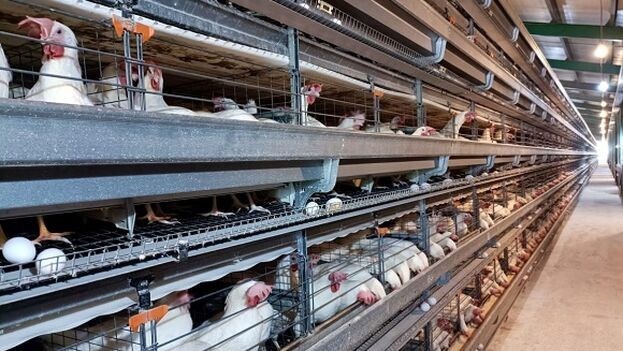
Officials regret not having enough litter, the product made from rice husks with which they feed the chickens.
By 14ymedio
HAVANA TIMES – Cuba’s official press celebrated, this Thursday, the operation of the 28 de Enero state poultry farm, in Pinar del Río. A production of 49,000 eggs per day, 61,144 hens and roosters, and a computer that monitors the “feeding, ventilation and collection of excrement” of the animals day and night make up, Cubadebate assures, a “perfectly synchronized gear.” The problem, however, is that this is a unique case in a country affected by the shortage of eggs and the serious lack of inputs for their production.
There is another exception, also in Pinar del Río: the ’Base Business Unit’ [UEB] Miguel Cabañas, not far from 28 de Enero, one of the 30 poultry farms in that province. However, Hurricane Ian, in September 2022, left the industry battered, which after the cyclone lost 4,000 chickens – almost all of them in the evacuation process – and which now has 53,000 animals and only one warehouse still standing of the previous eleven.
At a lower level of production and despite the “setbacks” alleged by its administrators, the UEB Turcios Lima, also from Pinar del Río, has 35,000 birds. However, the managers regret not having enough better, a product made from the husks of the rice with which they feed the chickens, in addition to the feed. That in use today comes from Sancti Spíritus and “does not satisfy the demand,” they point out. There is also no money, they add, to buy zeolite or wood chips, alternatives to feed the animals.
Food deficiencies have had serious consequences. Due to a “vitamin deficiency problem,” explains a Turcios Lima technician after several detours, the chickens are dying. However, he assures that medications and supplements were applied to the offspring to reduce the mortality rate.
In addition to the health problems of the animals, the list of deficiencies that affect the entire production is notable: there is no food, but also no fuel or inputs to achieve the basic conditions of comfort for the hens, whose egg production experiences a brutal drop due to these factors.
The country would need twice as many animals – and for them to lay twice as many eggs – to achieve satisfactory productive performance, estimates Jorge Luis Parapar, president of the Food and Poultry Business Group.
Asked about the number of eggs he is expected to guarantee for the ration system’s basic family basket, Parapar excused himself, insisting that all products have been drastically affected by the “impacts of the blockade” and the “economic situation.” The cost to produce an egg is 5.60 pesos, the official alleged, while they are sold for 2.08 in the ration stores. That difference “causes million-dollar losses for the company,” he complained.
Parapar commented on the situation in the informal market, which he described as a “very difficult task.” He assured that clandestine producers have “open farms in out-of-the-way places, where sometimes strict control becomes a bit difficult.” He is aware, he said, that the price of a 30-egg carton of eggs is 3,000 pesos, for the moment.
As 14ymedio found this Thursday, this amounts to 100 pesos for just one egg. He also did not refer to the online stores that Cubans must resort to, through purchases made from abroad by their emigrated relatives. Supermarket23, one of the most requested markets, was also selling a carton of 30 imported units this Thursday for $9.89 dollars.
To guarantee an acceptable level of production, the first variable to eliminate is the cultivation of feed, which farmers prefer to sell on their own – after going through many difficulties – to the population. If the State wanted to intervene to solve these deficiencies, it would have to obtain “fuel, transgenic seeds, fertilizers, pesticides and cutting-edge technology that is not available at the moment,” Parapar listed.
If these conditions were met, “we could satisfy the demand and have 10 or 15 eggs per month per consumer as before,” said the manager. Even so, Parapar urged Cubadebate readers to have confidence: after all, the national agriculture program “was designed by Fidel,” and is proof of difficulties, including the “tense situation” of the blockade.
Parapar dedicated a section to the characteristics of Cuban chickens, which are “very sensitive and get stressed easily.” The fuel crisis causes feed to arrive late to the farm, which affects the “egg laying.” However, even if they have low performance, “they eat the same amount of food,” he lamented.
There are also chickens that are on the verge of “decrepitude” and that the country uses for food. The “old” ones, the manager insisted, do not have the performance that his company expects of them, and half of the animals it has are in those conditions.
“Sometimes you add fuel at two or three in the morning, and when you arrive at the factory there is no electricity, and then you have to wait three or four hours for the production process to resume. On the other hand, there is a looming bad period in poultry farming because sunlight is shortened and the hen is a photoperiodic animal,” was his final complaint.
Translated by Translating Cuba
Read more from Cuba here on Havana Times




